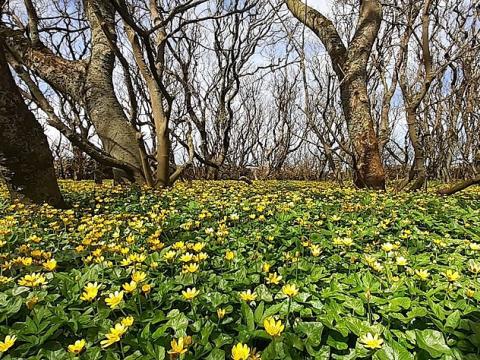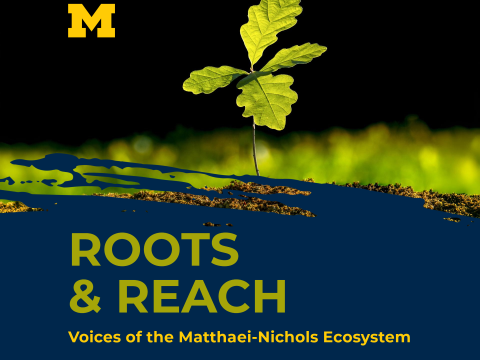Carmen Leskoviansky is a Collections and Natural Areas Specialist at MBGNA. She has a degree in horticulture from Michigan State University and has worked at MBGNA since 2009, caring for the bonsai collection since 2011. She is currently studying bonsai as an apprentice with Michael Hagedorn of Crategus Bonsai in Portland, Oregon and will return to Matthaei Botanical Gardens full time when her apprenticeship is complete.
Tell us a little bit about your passion for your work. What got you started with bonsai?
Getting into bonsai was purely accidental for me. I was hired in 2009 in a temporary capacity to work on caring for and restoring the Peony Garden at the arboretum. In 2011, I moved to a permanent horticulture position which included caring for all of the special collections, including bonsai. At this point, I didn’t know anything about bonsai outside of the fact that we had a collection.
For the first 6 months, I worked closely with, now retired, horticulturist, Connie Crancer, and the bonsai volunteers to learn how to care for the collection. Connie and I attended the American Bonsai Society Learning Seminars in Louisville, KY that summer, and that was my first real crash course in bonsai.
I had my son in 2013, a week after the Bonsai and Penjing Garden opened to the public. I came back in a part-time capacity in 2014, focused on the bonsai collection. In 2015, we began working with David DeGroot, former curator of the Pacific Bonsai Museum, to enhance the trees in our collection. It was also around this time we began discussions with Dr. Melvyn Goldstein regarding the donation of his collection. Between working with Dave and attending bonsai shows and workshops, I began to develop more skills.
With the acquisition of Mel’s trees, I wanted to gain more knowledge and technical skill to maintain the collection. So, in 2018, I began studying with Michael Hagedorn of Crataegus Bonsai located in Portland, OR. Michael ran seasonal intensive classes – 4 times a year (winter, spring, summer, fall) for 3 days at a time, for two years. It was here that I really, finally, got excited about bonsai. I had always liked it for the combination of art and horticulture, two disciplines I really enjoyed, but these intensives really inspired and challenged me. I didn’t just find bonsai, I found community.
The seasonal intensives were great fun and challenging. I knew that they wouldn’t be enough for me. I wanted to learn more and spend more time learning technical skills. So, in 2019, I opened up the idea of apprenticeship with both Michael and MBGNA, and the rest is history! Michael was looking for his next apprentice, and MBGNA was supportive. I moved out to Portland in 2021 to begin my apprenticeship Crataegus Bonsai. The apprenticeship runs just over three years and will wrap up in the fall of 2024 at which point I plan to come back to MBGNA to pick up where I left off maintaining the bonsai collection. In the meantime, I do have a 10% appointment with MBGNA so I can stay in the loop and help out as needed.
What draws you into the work you do?
I am passionate about bonsai for a number of reasons. The biggest reason being that there are innumerable ways to interpret and interact with bonsai.
Bonsai is more than creating or maintaining and displaying a tree. There is a story to tell. The various pieces of the display from the tree itself to the pot to the stand to the scroll to the accent and how everything relates to each other help to tell this story. Each of these elements of display is art in its own right, often created by someone who has dedicated their life to that discipline. From conception to display, there are multiple people and arts involved.
Most bonsai collections interpret bonsai through a more traditional Japanese lens. Our collection is unique because it is attached to a major research university. I would love to see the collection become a subject of research within various disciplines within UM. Not just art and design or Japanese studies, but architecture, engineering, sustainability, medicine, social justice, etc. Bonsai can be a vehicle to study within almost any discipline.
Bonsai is viewed more as an art in the US than in Japan where it is considered more of a craft. Not a craft like gluing pom poms to paper, but like woodworking or masonry – applied technical skill. Because Americans view bonsai as art, there is an opportunity to push the boundaries of design and display. The Japanese have perfected the technical skill and have a tradition for show and display that can’t be beat, BUT there is space outside of convention to explore, and it’s an interesting space to watch.
These are all pretty existential reasons why I am passionate about bonsai. On a more basic personal level, I enjoy the technical work. I have a creative personality and ADHD and bonsai allows me a space to get creative and be challenged and use both my mind and body at the same time. It is busy work at its finest.
Do you have any specific circumstances in which you faced a barrier with bonsai, or any challenges that you’ve faced specifically for being a woman in bonsai?
Many hobbies within Japanese culture were historically segregated by gender. Bonsai has traditionally been done by men, while hobbies like ikebana are traditionally done by women. Bonsai seems to be a male-dominated hobby and profession in the US as well. However, it does seem that worldwide, the gender gap is beginning to shrink.
My friend, Samantha Holm, wrote an article about the gender disparity within American bonsai for her local club – the Rocky Mountain Bonsai Society – which was then published in the Journal of the American Bonsai Society. Fewer financial and material resources, lack of time, and bonsai club culture are a few possible reasons for the gender disparity in bonsai. Yet women in bonsai do exist, and I have heard many stories about women in American bonsai as the first teachers of many of the men who are now professionals.In fact, the first American to apprentice in Japan was Kathy Shaner who just retired from a curator position at the Lake Merritt bonsai collection in Oakland, California. The history of many of these women is not well known and even many of the women who currently work on a professional level lack the same name recognition as their male counterparts.
Personally, I have been both lucky enough and privileged enough to not have as many barriers as some other women may face. I had to get used to being one of the youngest and one of the only women in the room, which was difficult. However, having a position caring for a bonsai collection gave me some credibility. Because I do bonsai as my job, I have access to the resources at UM which provides me with the tools, supplies, and training I need to be able to do my job well. Without the resources of the University, I would not have the bonsai education and skill I have today. I have been on the receiving end of sexist microaggressions, and I am aware of other women in bonsai enduring the same. It can be exhausting. Yet overall, many of the people I have met are kind and welcoming.
You co-founded a women’s bonsai group called The Purple Pot– tell us all about it!
Back in 2020, I was a guest on the Bonsai Wire Podcast which is hosted by my teacher, Michael Hagedorn, two of his former apprentices, Andrew Robson and John Eads, and his friend and colleague, Jonas Dupuich. I was being interviewed by Michael and Jonas, and we got onto the topic of purple bonsai pots. I was telling them the story of how at the National Bonsai Exhibition in Rochester NY, I had made a comment about how there weren’t many purple bonsai pots. Purple is my favorite color. One of the people I was with made a comment about how purple isn’t a good color for a bonsai pot, and I responded that some day I would have a bonsai in a purple pot in the National Exhibition. Jonas made a joke about creating the “Purple Pot Society” as a type of outsider art, break-the-rules bonsai club.
Shortly after this episode aired, I received an email from Samantha Holm from the Rocky Mountain Bonsai Society in Denver asking if I wanted to create a women’s bonsai club, something I had mentioned being passionate about for a while since I had noticed the gender disparity in bonsai. Thus, the Purple Pot Society was formed! We are still in the early stages of getting things running, but we are hosting a panel on women in bonsai at the American Bonsai Society Learning Seminars in Denver this June.
The mission of the PPS is to encourage and inspire women in bonsai and advocate for diversity and inclusion within the bonsai community. You can read more here.
Your bonsai apprenticeship sounds interesting. What are your favorite parts about it?
I’m almost two years into my apprenticeship, and it has been a great and challenging experience. I live on-site and manage the bonsai yard which has over 200 trees that range from display specimens to cuttings being rooted to create the next generation of bonsai. There are numerous species including some of the traditional Japanese species like Japanese black pine, shimpaku juniper, and Japanese maple to US native species like mountain hemlock, vine maple, and rocky mountain juniper.
I do everything from watering, fertilizing, and pest management to maintaining mature trees to designing raw stock and assisting with teaching students in the seasonal intensive classes. I wish I had kept a tally of how many hours I’ve spent wiring trees since the beginning because I do a LOT of wiring!
I came into the apprenticeship with a fair amount of experience from maintaining the collection at MBGNA and studying with Michael, and the work and repetition of the work I do here has solidified much of that knowledge as well as taught me new techniques and practices. Truly the best way to learn bonsai is through repetition. The more you do it, the better you get, and nothing quite beats full immersion.
I chose to study in the US with Michael because I like his teaching style, and I like how he styles his trees. They have a very natural, graceful look, and he has a few trees that break convention, and I always enjoy breaking conventions. I am also married and have a 9 year old, and the prospect of moving to Japan and taking on a traditional apprenticeship was too much. Though, I have visited Japan, and I would love to spend some time studying there in the future.





